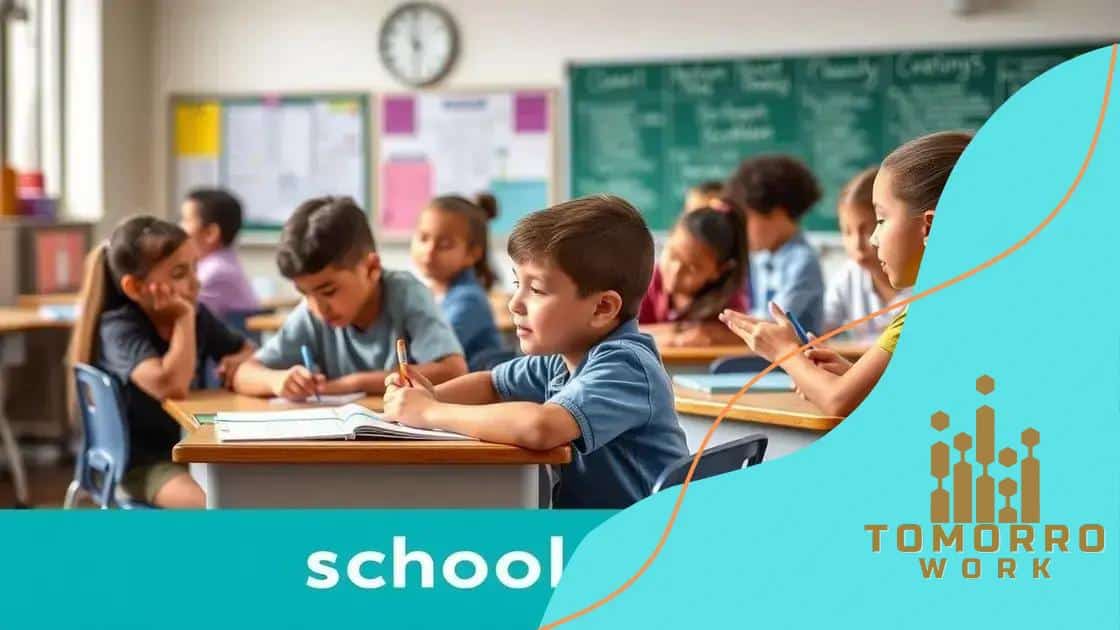School choice policy debates: understanding key arguments

Advertisements
School choice policies give families the flexibility to select educational institutions that align with their needs, offering personalized learning experiences.
However, these policies also raise concerns about equity and equal access to quality education.
The ongoing debates surrounding school choice continue to influence the education system, sparking discussions on its impact on access and educational quality.
Advertisements
Have you ever considered how these choices shape the experiences of students and families?
What is school choice policy?
School choice policy refers to the initiatives that allow parents to select the schools their children attend, rather than being assigned a school based on geographic location.
This concept has gained traction in recent years as a way to improve educational outcomes and provide families with more control over their children’s education.
Advertisements
There are various forms of school choice, including charter schools, voucher programs, and magnet schools.
Each offers unique opportunities for students, allowing them to pursue education in environments that best fit their needs.
Types of School Choice Programs
Among the options available, some have gained more popularity than others. Here are a few examples:
- Charter Schools: Independent public schools that have more flexibility in their operations.
- Voucher Programs: Government-funded scholarships that pay for students to attend private schools.
- Magnet Schools: Schools with specialized programs attracting students from various districts.
The expansion of school choice policies aims to create competition among schools, encouraging them to innovate and improve to attract students.
Proponents argue that this leads to better educational outcomes as schools strive to meet the needs of families.
Critics, however, raise concerns about equity and the potential negative impact on public schools.
They argue that public funding for private education may drain resources from public schools, potentially leading to disparities in education quality.
Impact on Students and Families
Ultimately, the impact of school choice on students and families is highly diverse. For some, it offers access to high-quality education that may not be available in their local public schools, enabling better opportunities for success.
For others, the debate raises concerns about accountability and the potential for unequal access to quality education.
As this discussion continues to evolve, it remains a significant factor affecting many families today.
Arguments for school choice

There are many arguments for school choice, and supporters believe that allowing parents to choose schools improves education for all students.
One reason school choice is favored is that it creates competition among schools. This competition can lead to better quality education because schools strive to attract and retain students.
Another important argument is that school choice offers more opportunities for families. Many parents want their children to attend schools that match their values, educational focus, or teaching style.
For example, some parents may prefer a school with a strong emphasis on the arts, while others might look for a focus on science and technology.
Benefits of School Choice
Supporters point out several specific benefits:
- Improved Student Outcomes: Studies often show that students in school choice programs achieve higher test scores and are more engaged in their learning.
- Diverse Learning Environments: Families can choose schools that cater to their child’s unique learning needs, promoting a more tailored educational experience.
- Increased Parental Involvement: When parents are able to choose their child’s school, they tend to become more invested in their education.
Furthermore, school choice policies can empower communities. By enabling families to select schools, communities can promote educational improvement in schools that need it the most.
As parents withdraw their children from underperforming schools, it pushes those schools to enhance their programs to retain students.
Opponents of traditional public schooling often argue that school choice can result in better outcomes for disadvantaged students.
Accessing different educational options can break cycles of poverty and provide pathways to success.
Understanding these arguments is essential to engaging in the broader discussion of education reform and access.
Arguments against school choice
While there are many arguments for school choice, there are also significant arguments against it that critics passionately advocate. One major concern is the risk of inequity in education.
Critics argue that school choice can lead to disparities between schools, as resources may be diverted from public schools, leaving them underfunded and unable to meet the needs of their students.
When funds follow students to other schools, public institutions often face budget cuts. This situation can create a vicious cycle where the schools that need the most support receive the least.
Parents in less affluent areas are also often limited in their choices, as they may not have the same access to high-quality options as wealthier families.
Concerns About Accountability
Another critical argument against school choice is the lack of accountability for private and charter schools.
Unlike traditional public schools, these institutions may not be held to the same standards of performance.
This discrepancy can lead to a situation where students in less regulated schools may not receive a comprehensive education.
Additionally, there is the concern that some schools may prioritize profit over student outcomes.
This focus can negatively impact the quality of education provided, as schools may cut corners on essential resources or qualified staff.
Impact on Community Schools
Community public schools may also suffer from school choice policies. When families opt for alternatives, local schools might lose both funding and students.
This may weaken the overall community, as schools often serve as vital community hubs. As these schools struggle, the relationships and connections within neighborhoods can weaken, eroding social capital.
Concerns about school choice underscore the importance of discussing educational equity and access.
It’s crucial to explore how these policies can affect students in various socioeconomic situations, making the debate a vital part of the broader conversation about education reform.
Impact on educational equity
The impact on educational equity is a crucial aspect of the school choice debate. As families gain the ability to choose schools, the question arises: does this choice benefit all students equally?
Many argue that school choice can create gaps in educational access, especially for underprivileged communities.
When parents from wealthier backgrounds can move their children to better-funded private or charter schools, public schools may lose essential resources.
This scenario often leaves the most disadvantaged students in under-resourced institutions, perpetuating existing inequalities in education.
Challenges Facing Low-Income Students
Low-income families may face particular challenges in accessing school choice options. Here are some key issues:
- Limited Access: Not all families have the same options available to them, often due to geographic location.
- Transportation Issues: Traveling to schools outside of their neighborhood can present significant logistical challenges.
- Awareness of Options: Some families may not be aware of the available choices, limiting their ability to make informed decisions.
These barriers can prevent school choice from being an equitable opportunity for all families.
Moreover, this situation can lead to increased segregation within the education system. As families choose schools based on factors like academic performance or cultural values, it can exacerbate divides based on socioeconomic status.
To genuinely enhance educational equity, it is essential to consider how school choice policies can be designed to do more than just offer options.
Policymakers must ensure that all families have equal access to high-quality education, regardless of their background.
Future trends in school choice policy

The future of school choice policy appears to be evolving rapidly. As education continues to change, several trends are emerging that may shape how families choose schools in the coming years.
One significant trend is the increasing popularity of online learning. With more families seeking flexibility, online schools offer a convenient option, particularly for those in rural areas or with unique scheduling needs.
Additionally, the implementation of personalized learning plans is gaining traction.
This approach allows students to learn at their own pace and provides tailored educational experiences. Schools that adopt this philosophy may attract families eager for customized education.
Growth of Charter and Magnet Schools
Charter and magnet schools are expected to expand further. Here are some reasons for this growth:
- Innovation in Education: These schools often operate with more flexibility, allowing for creative teaching methods and curricula.
- Specialized Programs: They frequently offer unique focuses, such as STEM, arts, or language immersion, attracting families looking for specific educational opportunities.
- Increased Funding: As public awareness and interest grow, these schools may receive more support from both public and private sectors.
Technology integration into the classroom is another critical trend. Schools are increasingly utilizing technology for interactive learning, enhancing the educational experience and engaging students more deeply.
This integration can also support individualized learning paths, making education more accessible.
Furthermore, the focus on equity is likely to shape future school choice policies. As more discussions arise about social justice, policymakers may need to address the inequalities that exist within the school choice framework.
Offering equitable access to quality education will be imperative in maintaining public trust and support.
FAQ – Frequently Asked Questions about School Choice Policies
What are the main benefits of school choice policies?
School choice policies offer flexibility, allowing families to select schools that best fit their children’s needs, often leading to improved educational outcomes.
What concerns exist regarding equity in school choice?
Critics argue that school choice can create disparities in education, especially for low-income families who may not have equal access to quality options.
How might technology impact the future of school choice?
The increasing integration of technology in education may enhance personalized learning experiences and broaden access to various educational resources.
What are some potential trends in future school choice policies?
Future trends may include more online schooling options, specialized programs in charter schools, and a stronger emphasis on ensuring equitable access to quality education.





